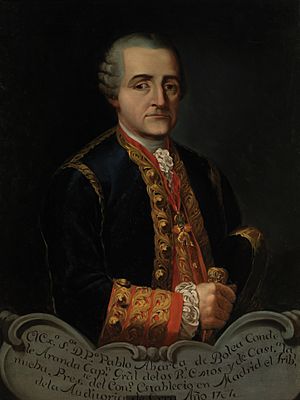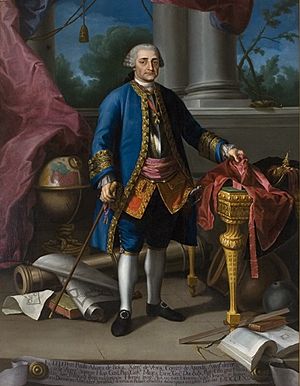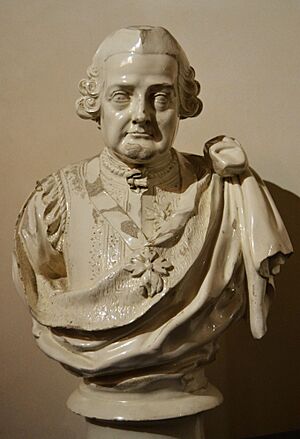Pedro Pablo Abarca de Bolea, 10th Count of Aranda facts for kids
Quick facts for kids
The Most Excellent
The Count of Aranda
|
|
|---|---|

Portrait by Francisco Jover y Casanova
|
|
| First Secretary of State | |
| In office 28 February 1792 – 15 November 1792 |
|
| Monarch | Charles IV |
| Preceded by | José Moñino |
| Succeeded by | Manuel Godoy |
| Personal details | |
| Born |
Pedro Pablo Abarca de Bolea y Ximénez de Urrea
|
| Nationality | Spanish |
Pedro Pablo Abarca de Bolea y Jiménez de Urrea, 10th Count of Aranda (born in 1718 in Siétamo, Huesca – died in 1798 in Épila, Saragossa) was an important Spanish statesman and diplomat. He played a key role in Spain during the Enlightenment period.
Contents
The Count of Aranda's Early Life and Career
Pedro Pablo Abarca de Bolea first started studying to become a priest in Bologna. However, at 18, he decided to join the Military School in Parma. By 1740, he was a captain in the Spanish Army. He fought in the War of the Austrian Succession.
He was badly wounded in 1743 and left for dead on the battlefield. After recovering, he temporarily left the military. He then traveled across Europe. He studied the Prussian Army and later helped bring their training methods to the Spanish army.
Learning in Paris
While in Paris, he met famous thinkers like Diderot, Voltaire, and D'Alembert. He studied the Encyclopédie and learned about the Enlightenment movement. This was a time when new ideas about reason and human rights were very popular. He also briefly visited London in 1754.
Diplomatic and Military Roles
Thanks to Prime Minister Ricardo Wall, King Ferdinand VI appointed Aranda as ambassador to Portugal in 1755. In 1757, he became the director general of Artillery. He soon resigned from this role and his military rank because he was not allowed to go after corrupt contractors.
In 1760, King Charles III sent him as ambassador to Poland. When he returned, he was sent to Portugal again. This time, he led the Spanish army that was invading Portugal. His forces captured the important town of Almeida. However, they had to retreat after British troops arrived. The war ended soon after with the Treaty of Paris.
Aranda's Influence as a Reformer
In 1763, Aranda became the captain general of the Province of Valencia. When the Esquilache Riots happened, he was appointed captain general of New Castile. He also became president of the Council of Castile. Because the king trusted him personally, Aranda had power similar to a prime minister.
He supported many Enlightenment reforms. One of his most notable actions was supporting the expulsion of the Jesuits from Spain in 1767. The Jesuits were a powerful religious order.
Dismissal and Later Diplomacy
Aranda's political rivals, especially Floridablanca, managed to get him dismissed. In 1773, he was appointed ambassador to France, where he stayed until 1787.
While in Paris, he thought about the future of the Spanish Empire after the United States gained independence. He suggested a plan for a Commonwealth. This plan involved creating three independent kingdoms in the Americas: Peru, Tierra Firme (which included New Granada and Venezuela), and Mexico. Each would have a Spanish infante (a royal prince or princess) on its throne. The Spanish king would still be the overall Spanish Emperor.

Count Aranda as Chief Minister
In 1792, Aranda returned to Spain. He replaced José Moñino, 1st Count of Floridablanca as the Secretary of State, which was like being the Prime Minister.
However, things changed quickly. In August 1792, King Louis XVI of France was imprisoned. In September, France became a republic. Aranda's ideas, which were based on the Enlightenment, seemed to clash with the idea of a total war against revolutionary France. Many European monarchies were preparing for such a war.
Because of this, Aranda was replaced by Manuel Godoy in November 1792. Later, after the Spanish Army lost a battle in Roussillon, Godoy and Aranda had a public argument in the Council of State. That same night, Aranda was arrested and sent to Jaén. A year later, he was pardoned and went to live on his estates in Aragon.
He was buried in the monastery of San Juan de la Peña.
Family Life
In 1749, Pedro Pablo Abarca de Bolea married Doña Ana. She was the daughter of the 9th duke of Híjar. They had one son, who died young, and a daughter.
See also
 In Spanish: Conde de Aranda para niños
In Spanish: Conde de Aranda para niños


